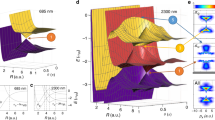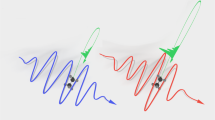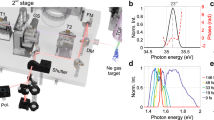Abstract
Experiments aimed at understanding ultrafast molecular processes are now routine, and the notion that external laser fields can constitute an additional reagent is also well established. The possibility of externally controlling a reaction with radiation increases immensely when its intensity is sufficiently high to distort the potential energy surfaces at which chemists conceptualize reactions take place. Here we explore the transition from the weak- to the strong-field regimes of laser control for the dissociation of a polyatomic molecule, methyl iodide. The control over the yield of the photodissociation reaction proceeds through the creation of a light-induced conical intersection. The control of the velocity of the product fragments requires external fields with both high intensities and short durations. This is because the mechanism by which control is exerted involves modulating the potentials around the light-induced conical intersection, that is, creating light-induced potentials.
This is a preview of subscription content, access via your institution
Access options
Subscribe to this journal
Receive 12 print issues and online access
$259.00 per year
only $21.58 per issue
Buy this article
- Purchase on Springer Link
- Instant access to full article PDF
Prices may be subject to local taxes which are calculated during checkout




Similar content being viewed by others
References
Brumer, P. W. & Shapiro, M. Principles of the Quantum Control of Molecular Processes (Wiley-Interscience, 2003).
Rice, S. A. & Zhao, M. Optical Control of Molecular Dynamics (Wiley-Interscience, 2000).
Klessinger, M. & Michl, J. Excited States and Photochemistry of Organic Molecules (VCH, 1995).
Tramer, A., Jungen, C. & Lahmani, F. Energy Dissipation in Molecular Systems (Springer-Verlag, 2005).
González-Vázquez, J., González, L., Solá, I. R. & Santamaría, J. Laser control of conical intersections: quantum model simulations for the averaged loss–gain strategies of fast electronic deactivation in 1,1-difluoroethylene. J Chem. Phys. 131, 104302 (2009).
Cederbaum, L. S., Chiang, Y-C., Demekhin, P. V. & Moiseyev, N. Resonant Auger decay of molecules in intense X-ray laser fields: light-induced strong nonadiabatic effects. Phys. Rev. Lett. 106, 123001 (2011).
Kim, J. et al. Control of 1,3-cyclohexadiene photoisomerization using light-induced conical intersections. J. Phys. Chem. A 116, 2758–2763 (2012).
Csehi, A. et al. Dressed adiabatic and diabatic potentials for the Renner–Teller/Jahn–Teller F+H2 system. J. Phys. Chem. A 117, 8497–8505 (2013).
Yuan, J-M. & George, T. F. Semiclassical theory of unimolecular dissociation induced by a laser field. J. Chem. Phys. 68, 3040–3052 (2008).
Bandrauk, A. D. & Sink, M. L. Photodissociation in intense laser fields: predissociation analogy. J. Chem. Phys. 74, 1110–1117 (1981).
Aubanel, E. E. & Bandrauk, A. D. Rapid vibrational inversion via time gating of laser-induced avoided crossings in high-intensity photodissociation. J. Phys. Chem. 97, 12620–12624 (1993).
Sändig, K., Figger, H. & Hänsch, T. W. Dissociation dynamics of H2+ in intense laser fields: investigation of photofragments from single vibrational levels. Phys. Rev. Lett. 85, 4876–4879 (2000).
González-Vázquez, J., González, L., Nichols, S. R., Weinacht, T. C. & Rozgonyi T. Exploring wave packet dynamics behind strong-field momentum-dependent photodissociation of CH2BrI+. Phys. Chem. Chem. Phys. 12, 14203–14216 (2010).
Garraway, B. M. & Suominen, K-A. Adiabatic passage by light-induced potentials in molecules. Phys. Rev. Lett. 80, 932–935 (1998).
Gedanken, A. & Rowe, M. D. Magnetic circular dichroism spectra of the methyl halides. Resolution of the n→σ* continuum. Chem. Phys. Lett. 34, 39–43 (1975).
Loo, R. O., Haerri, H-P., Hall, G. E. & Houston, P. L. Methyl rotation, vibration, and alignment from a multiphoton ionization study of the 266 nm photodissociation of methyl iodide. J. Chem. Phys. 90, 4222–4236 (1989).
Chandler, D. W. & Houston, P. L. Two-dimensional imaging of state-selected photodissociation products detected by multiphoton ionization. J. Chem. Phys. 87, 1445–1447 (1987).
Guo, H. Three-dimensional photodissociation dynamics of methyl iodide. J. Chem. Phys. 96, 6629–6642 (1992).
Amatatsu, Y., Yabushita, S. & Morokuma, K. Full nine dimensional ab initio potential energy surfaces and trajectory studies of A band photodissociation dynamics: CH3I* →CH3 + I, CH3 + I*, and CD3I*→CD3 + I, CD3 + I*. J. Chem. Phys. 104, 9783–9794 (1996).
Eppink, A. T. J. B. & Parker, D. H. Methyl iodide A-band decomposition study by photofragment velocity imaging. J. Chem. Phys. 109, 4758–4767 (1998).
Eppink, A. T. J. B. & Parker, D. H. Energy partitioning following photodissociation of methyl iodide in the A band: a velocity mapping study. J. Chem. Phys. 110, 832–844 (1999).
Xie, D., Guo, H., Amatatsu, Y. & Kosloff, R. Three-dimensional photodissociation dynamics of rotational state selected methyl iodide. J. Phys. Chem. A 104, 1009–1019 (2000).
de Nalda, R. et al. A detailed experimental and theoretical study of the femtosecond A-band photodissociation of CH3I. J. Chem. Phys. 128, 244309 (2008).
Rubio-Lago, L., García-Vela, A., Arregui, A., Amaral, G. A. & Bañares, L. The photodissociation of CH3I in the red edge of the A-band: comparison between slice imaging experiments and multisurface wave packet calculations. J. Chem. Phys. 131, 174309 (2009).
Gross, P., Neuhauser, D. & Rabitz, H. Teaching lasers to control molecules in the presence of laboratory field uncertainty and measurement imprecision. J. Chem. Phys. 98, 4557–4566 (1993).
Sussman, B. J., Townsend, D., Ivanov, M. Y. & Stolow, A. Dynamic stark control of photochemical processes. Science 314, 278–281 (2006).
González-Vázquez, J., Solá, I. R., Santamaría, J. & Malinovsky, V. S. Quantum control of spin–orbit coupling by dynamic Stark-shifts induced by laser fields. Chem. Phys. Lett. 431, 231–235 (2006).
González-Vázquez, J., Solá, I. R., Santamaría, J. & Malinovsky, V. S. Vibrationally state-selective spin–orbit transfer with strong nonresonant pulses. J. Phys. Chem. A 111, 2670–2678 (2007).
Chang, B. Y., Shin, S. & Sola, I. R. Further aspects on the control of photodissociation in light-induced potentials. J. Chem. Phys. 131, 204314 (2009).
Chang, B. Y., Shin, S., Santamaría, J. & Solá, I. R. Bond breaking in light-induced potentials. J. Chem. Phys. 130, 124320 (2009).
Suominen, K-A. & Garraway, B. M. Wave-packet dynamics: level-crossing-induced changes in momentum distributions. Phys. Rev. A 48, 3811–3819 (1993).
Corrales, M. E., Balerdi, G., Loriot, V., de Nalda, R. & Bañares, L. Strong field control of predissociation dynamics. Faraday Discuss. 163, 447–460 (2013).
Eppink, A. T. J. B. & Parker, D. H. Velocity map imaging of ions and electrons using electrostatic lenses: application in photoelectron and photofragment ion imaging of molecular oxygen. Rev. Sci. Instrum. 68, 3477–3484 (1997).
Vredenborg, A., Lehmann, C. S., Irimia, D., Roeterdink, W. G. & Janssen, M. H. M. The reaction microscope: imaging and pulse shaping control in photodynamics. ChemPhysChem 12, 1459–1473 (2011).
Garcia, G. A., Nahon, L. & Powis, I. Two-dimensional charged particle image inversion using a polar basis function expansion. Rev. Sci. Instrum. 75, 4989–4996 (2004).
García-Vela, A., de Nalda, R., Durá, J., González-Vázquez, J. & Bañares, L. A 4D wavepacket study of the CH3I photodissociation in the A-band. Comparison with femtosecond velocity map imaging experiments. J. Chem. Phys. 135, 154306 (2011).
Peterson, K. A., Shepler, B. C., Figgen, D. & Stoll, H. On the spectroscopic and thermochemical properties of ClO, BrO, IO, and their anions. J. Phys. Chem. A 110, 13877–13883 (2006).
Werner, H-J. et al. MOLPRO, version 2012.1, a package of ab initio programs (http://www.molpro.net. 2012).
Alekseyev, A. B., Liebermann, H-P. & Buenker, R. J. An ab initio study of the CH3I photodissociation. II. Transition moments and vibrational state control of the I* quantum yields. J. Chem. Phys. 126, 234103 (2007).
Shapiro, M. Photophysics of dissociating methyl iodide: resonance Raman and vibronic photofragmentation maps. J. Phys. Chem. 90, 3644–3653 (1986).
Feit, M., Fleck J. Jr & Steiger, A. Solution of the Schrödinger equation by a spectral method. J. Comp. Phys. 47, 412–433 (1982).
Feit, M. D. & Fleck, J. Solution of the Schrödinger equation by a spectral method. II: Vibrational energy levels of triatomic molecules. J. Chem. Phys. 78, 301–308 (1983).
Feit, M. D. & Fleck, J. Wave packet dynamics and chaos in the Hénon–Heiles system. J. Chem. Phys. 80, 2578–2584 (1984).
Kosloff, R. Propagation methods for quantum molecular dynamics. Ann. Rev. Phys. Chem. 45, 145–178 (1994).
Acknowledgements
This work was financed by the Spanish Ministry of Economy and Competitiveness (MINECO) through grants CTQ2008-02578, CTQ2012-37404-C02-01 and CTQ2012-36184, Consolider program SAUUL CSD2007-00013 and the European Union Initial Training Networks ‘Ultrafast control of quantum systems by strong laser fields’ (FASTQUAST, PITN-GA-2008-214962). This research was performed within the Unidad Asociada ‘Química Física Molecular’ between the Departamento de Química Física of Universidad Complutense de Madrid (UCM) and Consejo Superior de Investigaciones Científicas (CSIC). J.G-V. thanks the Spanish MINECO for a Juan de la Cierva grant and the PIM2010ECC-00751 project for financial support. The facilities provided by the Centro de Asistencia a la Investigación de Láseres Ultrarrápidos at UCM and the computational resources of the ‘Trueno’ cluster at CSIC are acknowledged.
Author information
Authors and Affiliations
Contributions
M.E.C. and J.G-V. contributed equally to the paper. M.E.C. and G.B. performed the experiments and analysed the experimental data. J.G-V. designed and performed the calculations. I.R.S. conceived and designed the calculations and is responsible for the theoretical interpretation of the results. R.N. and L.B. conceived and designed the experiments. All authors contributed to writing sections of the paper.
Corresponding authors
Ethics declarations
Competing interests
The authors declare no competing financial interests.
Supplementary information
Supplementary information
Supplementary information (PDF 319 kb)
Supplementary information
Supplementary Video 1a (AVI 804 kb)
Supplementary information
Supplementary Video 1b (AVI 928 kb)
Supplementary information
Supplementary Video 1c (AVI 987 kb)
Supplementary information
Supplementary Video 1d (AVI 946 kb)
Rights and permissions
About this article
Cite this article
Corrales, M., González-Vázquez, J., Balerdi, G. et al. Control of ultrafast molecular photodissociation by laser-field-induced potentials. Nature Chem 6, 785–790 (2014). https://doi.org/10.1038/nchem.2006
Received:
Accepted:
Published:
Issue Date:
DOI: https://doi.org/10.1038/nchem.2006
This article is cited by
-
Carrier-envelope-phase measurement of sub-cycle UV pulses using angular photofragment distributions
Communications Physics (2022)
-
Probing multiphoton light-induced molecular potentials
Nature Communications (2020)
-
Polaritonic molecular clock for all-optical ultrafast imaging of wavepacket dynamics without probe pulses
Nature Communications (2020)
-
Elucidating the origins of multimode vibrational coherences of polyatomic molecules induced by intense laser fields
Nature Communications (2017)
-
Electrons dynamics control by shaping femtosecond laser pulses in micro/nanofabrication: modeling, method, measurement and application
Light: Science & Applications (2017)



